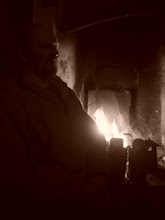Outdoor cookery guide
Outdoor cookery is an entertaining and fun way for enjoy your meals. Whether on the BBQ or over an open fire there are a few tips and tricks that can help you get the most from your experience.
Aside from the recreation aspects of cooking we should also consider its importance in bushcraft – a tasty meal, well presented would boost morale, lift flagging spirits and in many ways make what might be a terrifying experience less daunting. As well a feeding the spirit we are also feeding the body so we need to ensure we utilize all the nutrients and goodness of each meal by avoiding over cooking and controlling waste (waste of fuel and water as well as food).
Just like any budding Jamie Oliver, an outdoor chef needs to learn a few basic techniques before he can begin to enjoy those tasty treats that await him.
Ground oven cook times.
Food cannot be burnt or spoilt if cooked in a correctly constructed ground oven. Always allow the correct time so that your food can cook through. As a rule of thumb, I always add a little extra to be safe.
Haunch of Deer, pig or goat
2 Hours per Lb
Outdoor cookery is an entertaining and fun way for enjoy your meals. Whether on the BBQ or over an open fire there are a few tips and tricks that can help you get the most from your experience.
Aside from the recreation aspects of cooking we should also consider its importance in bushcraft – a tasty meal, well presented would boost morale, lift flagging spirits and in many ways make what might be a terrifying experience less daunting. As well a feeding the spirit we are also feeding the body so we need to ensure we utilize all the nutrients and goodness of each meal by avoiding over cooking and controlling waste (waste of fuel and water as well as food).
Just like any budding Jamie Oliver, an outdoor chef needs to learn a few basic techniques before he can begin to enjoy those tasty treats that await him.
Ground oven cook times.
Food cannot be burnt or spoilt if cooked in a correctly constructed ground oven. Always allow the correct time so that your food can cook through. As a rule of thumb, I always add a little extra to be safe.
Haunch of Deer, pig or goat
2 Hours per Lb
Rabbit or Hare
4 hours
Squirrel
2 hours
Fish
45 mins – 1 hour
Shell fish
30 – 45 mins
Crab (small)
30 – 45 mins
Roots and tubers
3 – 5 hours
seaweeds
3 hours
Steaming times
Steaming works well on small game – to cook larger fare fire management is essential.
Fish
20 – 40 mins
Rabbit or Hare
2 hours
Shell fish
1 hour (discard any that remain closed)
Roots and tubers
4 – 5 hours
These are a few of the more expedient techniques you will be using as the series progresses – while steaming and ovens are good ways to cook don’t forget you can also boil your food as well as broiling and frying.
Let us look at rations – military rations and camping foods will be covered in later issues but for now, I want to get right back to basics – using ingredients readily available around the world both past and present.
In the heyday of the Fur brigades of the Rocky Mountains large companies such as the Hudson Bay Company and the North West Company issued their trappers and Voyageurs with rations, below is a list of what each man would received.
HBC ration: _
2 Lbs flour or 11/2 lbs sea biscuits (pilot bread)
1 lb fat mess pork (salt pork with no meat – what is called fat back)
2 oz sugar
½ oz Tea
½ oz salt
½ oz carbonate of soda (baking soda – for leavening Bannock bread)
2 oz peas or 2 oz barley
The peas and barley where intended to be boiled along side any game taken upon the trail.
This ration per man would weight 347 pounds if rationed for a 15-day trip.
NWC Voyageur’s meal
1 quart dried peas
4 oz salt pork
1 or 2 hardtack biscuits (British military rations have these called Biscuits AB or use can use 4 - 6 crackers)
The voyageurs who fixed this meal ate only once a day and usually around a communal cooking pot.
From these two examples, you can see how plain and simple rationing a trip can be. Below is a meal taken from an original recipe that will transport you back to the 1800’s.
Voyageur Stew
Taking the ingredients above, soak the quart of peas until the skins split. Add salt pork chopped into cubes and simmer for 5 hour (over an open fire or until meat is tender on stove) topping up the water as needed.
When ready add the broken hardtack biscuits and stir in until the whole stew becomes thick.
Then enjoy.
Just like the wily old trapper or mountain man we can carry with us a few basic ingredients that will (with a little imagination) stretch to serve us in a whole host of different ways. These ingredients may be all that are open to the modern explorer especially in some third world country’s but more importantly they offer us versatility in our cooking as well as being a important source of carbohydrates.
Batterdough – this is a multipurpose Bannock mix adaptable to various meals and needs
If we carry the below dry ingredients with us upon the trail we can cook ourselves anything from a simple Bannock or Fire bread, golden and tasty Pan Cakes, plump stodgy mouth watering dumplings or even a tasty pie crust or Pizza.
The list is simple. To cut down on weight you should only carry what you think you will need maybe even premixing the dry ingredients at home and carrying them in zip lock bags.
Plain flour
Suet
Baking Powder
Salt and Sugar.
I usually work on a daily ration of 2lbs flour, 2oz o sugar, ½ oz Salt, ½ oz Baking powder, 1lb suet (Taken from Hudson bay company daily rations) Unless I’m carrying other food stuff then I will carry less.
The below ingredients will make one bannock to serve 2 or 10 – 12 Canadian style pancakes.
10 heaped spoonfuls of flour
1 level spoonful of baking powder
4 spoonfuls of sugar
1/8 – 1/2 of a spoonful of salt
*A spoon being the size of spoon you have with you but deemed to be roughly tablespoon size)
Mix the above ingredients allowing as much air as possible to entire the mix. When ready slowly add water and work this in little by little. For a bannock, you will want a round cannon ball of quite stiff dough.
Grease a cooking pot with melted suet and place the dough inside. Slice a cross across the bannocks top then cover with a lid and bake over the fire or in an oven until ready (check after above 20 mins at medium heat.)
Other uses,
The bannock mixture can also be cooked on a plank or wrapped around a stick (in both cases use none toxic woods) as well as in an oven or pot, ensure the plank is heated before you add the dough.
Used as a base for a pizza bread - replace plain water with 50/50 mix of water and sun dried tomato oil (or all oil) also mix into the dough salami and sun dried tomatoes then fry in melted suet.
By replacing the sugar with suet (8 spoonfuls), you can use this as a dumpling mix. (More suet if you like ‘em stodgy!)
By replacing the baking powder and sugar with 5 spoonfuls of suet, you can make a passable piecrust.
To make pancakes mix the above ingredients with water until it forms a batter. Grease a frying pan (melted suet) and fry spoon sized lumps of batter turning once to golden on both sides. Even better if you have it fry the pancakes in bacon fat and serve with Maple syrup.
Mixing the bannock mixture with beer (traditional ales) to replace water makes a tasty treat and saves on your valuable water supplies.
Nettle soup.
Can be used as an accompaniment to our Bannock or as a meal in its own right.
4 large handfuls of Nettle tops
1 large onion (optional or add Ramsons, hedge garlic and chives))
I large spoon (heaped) butter (optional)
2 pints vegetable stock, bouillon, or chicken soup.
Salt and pepper– or paprika, chilli sauce to taste
Make up stock and bring to a slow simmer. Add chopped onion and butter and allowed to simmer until onion is soft. Stir in nettle tops and bring back to boil.
Once boiling add any further liquid as required and again allow to return to the simmer for a further 5 mins. (If using hedge garlic add last just before serving and finely chop)
Season to taste.
Serve.
An interesting meal can be made by pureeing nettles tops (cooking in enough water to stop them burning and then mash once done) serve with a poached egg.
Food AND Water a wilderness guide
We all know that we need food to live. You are what you eat pretty much sums up our western attitude to food but in reality food is really of the least importance especially in an emergency situation.
However, if food’s importance is decreased waters importance is tripled. Not only do we need water for drinking but we also need it for cooking, washing and numerous other tasks.
With this in mind, I would like to point out the following facts.
Food.
You can fast for between 40 to 120 days. You may survive longer by fasting if you cannot,
Find more than 1000 calories on a daily basis.
Find 500 grams of Carbohydrate a day
If you use more energy getting food than you intake from it.
This sounds extreme but it will allow the body to go into starvation mode and in this state it will burn fuel efficiently – adding small amounts of Carbohydrate will hinder this and (as you will see below) cause you to suffer the effects of carbohydrate deprivation over and over – a most uncomfortable state of affairs. Bear in mind that we seem to fear being hungry without really understanding the effects of hunger and its effects on our bodies. We will cover more about this in later articles.
Water
You can go without it for approximately 3 days (longer in some cases 4 to 6 being the maximum)
With adequate sleep and water in take you will live until you starve to death.
However, without sufficient water you should refrain from eating and smoking as both dehydrate you. Lack of water rapidly affects the body so remember the old adage - Ration sweat not water.
Thirst is not a guide to dehydration – check urine colour regularly as this is more accurate - clear or straw coloured is good anything darker indicates dehydration. Your best water container is your body so keep it tanked up always. There have been numerous occasions where tourists and people caught out by many of the worlds deserts have perished yet surprisingly enough when their bodies are recovered they are often found to still have water in their canteens.
As a rule of thumb always try to drink at least 2 litres of water a day – I like to carry a 2 quart canteen (approx 3 pints) in my rucksack as back up to my 1 litre bottle.
While water is heavy to carry (it gets lighter as you drink it) YOU SHOULD ALWAYS CARRY SOME.
Carbohydrates, relative values.
As mentioned above we need carbohydrates in our diet as these boost our blood sugar level and kick in to provide a quick release energy this being what our bodies, our muscles in particular would rather feed upon.
However, the glycin reserves we carry within us will only last approx two days or so and after this period we will start to burn fat or more importantly our subcutaneous fats, which our body uses as insulation amongst over things.
If this happens carbohydrate, deprivation will result and with it we will experience the following symptoms (especially if we are used to a normal starchy western diet):-
· Tiredness
· Headaches
· Loss of concentration
· Irritability
· Depression
· Self absorption
· And a feeling of continual cold.
All of these can make our experiences harder and in doing so lower our morale, most dangerous of all would be its effects on our levels of concentration. It is therefore a good idea to carry a small emergency ration pack a part of which should be your daily Carb’ intake as mentioned above.
With this in mind, it is wise to carry other ingredients to boost your meal. For additional ingredients I usually look to those that contain proteins and sugars (glucose sweets or Kendal mint cake are ideal) Also carry things you enjoy eating after all that will be a small boost to your morale if nothing else.
I usually prefer to carry rations that do not require re-hydrating in any way, as this is a drain on your valuable water resources, which would, in reality, be better off being drunk.
Worse than wasting precious water, if you are injured or unable to light a fire you will also be unable to feed your internal boiler and so you will start to feel colder and this will increase your chances of a cold injury or worse.
I usually carry the following:-
2 x 50g Beef Jerky
Drinking Chocolate.
Kendal mint cake.
Remember these are emergency rations but they still allow me to have a degree of versatility. The dried meat can be eaten without cooking while the chocolate can be made into either a hot or cold drink as well as acting as flavouring for many other things. The Kendal mint cake (being almost totally sugar) is where a lot of carb’s are stored and this, as well as being full of moral boosting flavour, is pack full of instant energy.
In addition to those above, I usually carry additional e/rats (emergency rations) in my Daysack and these include,
Chewing gum (these help relieve thirst in the short term and contain sugars)
Salt (many uses including flavouring and preservation)
Seasoning (curry powder/chilli powder or Tabasco sauce all improve the bland taste of wild fare).
Bouillon or Vegetable stock cubes.
Rice or Powdered Mash.
Boil in the bag meal (if room or weight allows)
Yet let me once again point out that while food is comforting, it is normally your last priority so concentrate your efforts on finding shelter, fire and water. We westerners tend to eat far more than we actually need to and so our stomachs and our habits tend to make us feel hungry even if we are not.
Boredom will also lead to hunger pains however these can be banished by action. In the bush there will always be something else that needs doing even if it is just collecting more firewood so if you begin to feel hungry distract yourself by working at tasks that will benefit you in the long run and take your mind off your stomach in the short term.
In real terms, it generally takes three days for the body to go into starvation/survival mode. This is the point where we will start to feed off our own stored proteins such as subcutaneous fats. Once you reach this point, hunger will diminish or disappear and you will find your senses becoming very much sharper allowing you to forage more effectively because your soft western body has suddenly woken up and started to act as it was designed to do. (This is something you need to experience to believe for it is truly amazing.)
With this in mind the canny bushman (even if they have food available) should consider the possibility of fasting for the first three days of any emergency situation or adventure.
In a short term situation (most rescues happen in three or less days) carrying a small emergency rations will help you fend off hunger pains and lift your morale. If you are confident rescue will not be long in coming you could eat your eat rations anytime.
Nevertheless always remember the advice on fasting and before worrying about food sources ensure your water supply is adequate for your situation.
Finally while wild foods are useful and can be a meal in themselves or can boost your normal rations it cannot be stressed enough that you should only eat what you can not positively identify and NEVER believe or use edibility tests these were designed for soldiers in escape scenario’s and done properly take many days to carry out.
























No comments:
Post a Comment